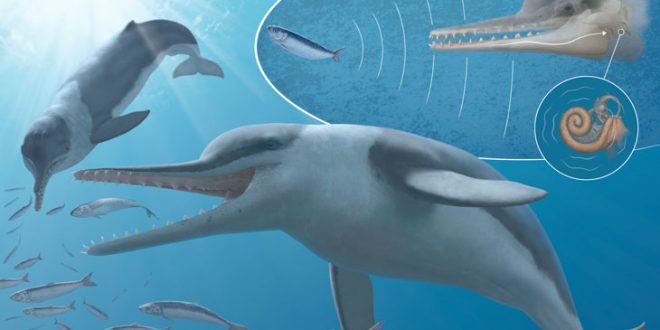Scientists have found that whales’ ultrasonic hearing has an ancient history. Their high-frequency hearing abilities arose earlier than anticipated. Morgan Churchill of New York Institute of Technology in Old Westbury, New York, said that the high-frequency hearing of whales may have preceded the emergence of echolocation.
The inner-ear fossil, estimated at 24 to 27 million years of age and uncovered from a drainage ditch in South Carolina, represents one of the oldest ever found.
The results, published in the journal Current Biology, also suggest that ultrasonic hearing pre-dated echolocation in ancient whales – a method of navigation whereby whales send out vocal signals to gauge their proximity to objects and prey.
Echolocation is best achieved using high-frequency sounds, which require ultrasonic hearing to process. Only bats come close to matching whales’ abilities in the ultrasonic hearing stakes.
It was previously believed that toothed whales, which evolved from land-dwelling animals tens of millions of years ago, evolved from low-frequency specialists into the ultrasonic superstars they are today.
However, CT scans of Echovenator’s inner-ear fossil revealed a different story. X-ray imaging of the fossil was compared to modern-day whales, and the toothed whale’s closest living relative – the hippopotamus.
The fossil’s similarities to the inner-ears of modern-day whales suggest the animal heard higher frequencies than its land-dwelling counterparts. This would mean the evolution of whales’ ears happened extremely quickly and very early on.
“Echovenator already shows skull features associated with echolocation, although it perhaps couldn’t have processed signals from echolocation as well as modern dolphins,” Churchill told reporters.
Echovenator is also surprisingly small compared to today’s toothed whales, suggesting a rapid evolution of body size early on in the species’ timeline. This probably contributed significantly to the development of whale ecology over time.
The research team is in the process of studying a number of toothed whale fossils from the same site in South Carolina, which may reveal more about the evolution of one of the world’s oldest living creatures.
“Echolocation is probably one of the most remarkable and unique adaptations within mammals. Out of 6,000 mammal species alive today, only bats and toothed whales, along with a very small number of small insectivores, use echolocation as a major way of navigating their environment,” Churchill said.
Agencies/Canadajournal

 Canada Journal – News of the World Articles and videos to bring you the biggest Canadian news stories from across the country every day
Canada Journal – News of the World Articles and videos to bring you the biggest Canadian news stories from across the country every day

